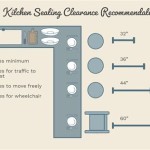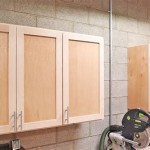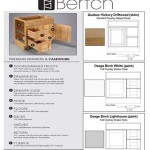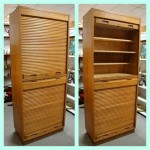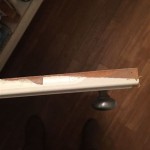How to Organize Kitchen Cabinets for Pots and Pans
Organizing kitchen cabinets, particularly those housing pots and pans, can significantly improve kitchen efficiency and reduce frustration during meal preparation. A well-organized cabinet simplifies the task of locating the necessary cookware, saving time and effort. This article outlines a systematic approach to organizing pots and pans in kitchen cabinets, from initial decluttering to implementing storage solutions, ensuring a functional and aesthetically pleasing kitchen space.
Decluttering and Assessment
The initial step in organizing any space is to declutter. This involves removing all pots and pans from the cabinets and assessing their condition and frequency of use. Examine each item for damage, such as warped bottoms, loose handles, or excessive rust. Items in poor condition should be discarded or recycled appropriately.
Consider the frequency with which each pot or pan is used. Seldom-used items, such as specialized cookware or those used only for holiday meals, can be stored in less accessible locations, such as higher shelves or in a pantry. Prioritize frequently used pots and pans for easy access on lower shelves or in drawers.
Matching lids to pots and pans is crucial for efficient storage. Discard any lids that do not fit existing cookware. If mismatched lids are kept for potential future use, store them separately in a designated container. Grouping lids by size can simplify the process of finding the correct lid when needed.
Once the decluttering process is complete, clean the interior of the cabinets thoroughly. Remove any crumbs, dust, or spills from the shelves and walls. This provides a clean slate for organizing and prevents attracting pests. Consider lining the shelves with shelf paper or non-slip mats to protect the cabinet surfaces and prevent cookware from sliding.
Optimizing Cabinet Space and Layout
The next phase involves strategizing the layout of pots and pans within the cabinets. This depends on the cabinet configuration, available space, and individual preferences. Different organizing methods cater to various needs and kitchen designs. One effective approach is to categorize cookware based on size and type, assigning specific shelves or areas for each category.
Larger and heavier pots and pans, such as stockpots and cast-iron skillets, are best stored on lower shelves or in deep drawers. These areas are more accessible and reduce the risk of strain when lifting heavy items. Smaller saucepans and frying pans can be stored on higher shelves or in shallower drawers. This segregation by size and weight promotes safety and ease of access.
Consider utilizing vertical space within the cabinets. Shelf organizers or risers can create multiple tiers, allowing for stacking pots and pans without making it difficult to retrieve items. These organizers are particularly useful in cabinets with high shelves, maximizing the available space and preventing items from getting lost at the back.
Another option is to use pull-out shelves or drawers. These allow for easy access to items stored at the back of the cabinet, eliminating the need to reach and shuffle items around. Pull-out shelves are particularly beneficial for individuals with limited mobility or for storing heavy cookware.
For those with limited cabinet space, consider utilizing wall-mounted pot racks. These racks can be installed above the stove or on a nearby wall, providing easy access to frequently used pots and pans while freeing up cabinet space. Ensure the pot rack is securely mounted and can support the weight of the cookware.
Implementing Storage Solutions and Techniques
Several storage solutions and techniques can further enhance the organization of pots and pans in kitchen cabinets. These options range from simple organizers to specialized storage systems, each offering unique benefits and catering to different budgets and preferences.
Lid organizers are essential for keeping lids neatly stored and easily accessible. These organizers come in various forms, including adjustable dividers, tiered racks, and door-mounted holders. Choose an organizer that best suits the available space and the number of lids to be stored. Keeping lids organized prevents them from cluttering the cabinet and simplifies the process of finding the correct lid.
Pot and pan dividers are another useful tool for preventing cookware from stacking and scratching. These dividers create individual compartments for each pot or pan, ensuring they remain separated and protected. Dividers can be adjustable to accommodate different sizes of cookware and can be easily installed within cabinets or drawers.
Stackable cookware sets are designed to nest together, minimizing the amount of space required for storage. These sets typically include pots and pans of varying sizes that fit neatly within each other, saving valuable cabinet space. When purchasing new cookware, consider investing in a stackable set to optimize storage efficiency.
Drawer dividers are useful for organizing pots and pans stored in drawers. These dividers create defined compartments within the drawer, preventing cookware from shifting and colliding. Drawer dividers can be customized to fit the specific dimensions of the drawer and the size of the cookware being stored.
Consider labeling shelves or drawers to further enhance organization. Labels can indicate the type of cookware stored in each location, making it easier to locate items quickly. This is particularly helpful for households with multiple cooks or for individuals who frequently rearrange their kitchen.
Implementing the "first in, first out" principle can help prevent cookware from becoming forgotten at the back of the cabinet. When putting away pots and pans, place newly cleaned items behind those that are already stored. This ensures that all cookware is used regularly and prevents items from accumulating unused at the back.
Another technique involves storing similar items together. For example, all frying pans could be stored in one area, while all saucepans are stored in another. This categorization simplifies the process of finding the desired cookware and promotes a more organized and efficient kitchen.
Periodically reassess the organization of the cabinets and make adjustments as needed. As cooking habits change or new cookware is acquired, the organization system may need to be updated to accommodate these changes. Regular maintenance ensures that the cabinets remain organized and functional over time.
Consider the weight distribution within the cabinets. Avoid placing excessively heavy items on high shelves, as this can create a safety hazard. Distribute the weight evenly throughout the cabinets, placing heavier items on lower shelves and lighter items on higher shelves.
If space is limited, consider storing lids separately from pots and pans. Lids can be stored in a door-mounted organizer or in a designated lid container. This frees up space within the cabinets and prevents lids from hindering the storage of pots and pans.
When storing cast-iron cookware, ensure it is properly seasoned and protected to prevent rust. Store cast-iron skillets in a dry location and avoid stacking them on top of other cookware. Consider placing a cloth or paper towel between cast-iron items to protect the seasoning.
For those who frequently bake, consider dedicating a specific cabinet or area for baking supplies and cookware. This can include mixing bowls, measuring cups, baking sheets, and cake pans. Keeping these items together streamlines the baking process and prevents them from getting mixed up with other cookware.
When organizing cabinets, consider the proximity to the stove and oven. Frequently used pots and pans should be stored in cabinets that are easily accessible from the cooking area. This minimizes the distance traveled and streamlines the cooking process.
Finally, involve all members of the household in the organization process. This ensures that everyone is aware of the organization system and can contribute to maintaining it. Collaboration can also lead to valuable insights and suggestions for improving the organization of the kitchen cabinets.

10 Awesome Tips For Organizing Pots And Pans A Cultivated Nest

Organizing Your Pots And Pans Jamonkey

Organizing Pots And Pans Elite Kitchen Blog

11 Genius Ways To Organize Pots Pans Organization Obsessed

Get Your Kitchen Organized With These Awesome Ideas For Organizing Pots And Pans Proch Organization Diy Pan Storage Cabinet

Organizing Pots And Pans In A Corner Cabinet Smallish Home

Diy Knock Off Organization For Pots Pans How To Organize Your Kitchen Frugally Day 26 Organizing Homelife

How To Organize Pots And Pans According Designers

Spring Cleaning Diy Organized Pots And Pans Cookware Drawer
:max_bytes(150000):strip_icc()/overthedoorpotlidorganizer-bf81a6cfedb04f86bc2c62eb27d8e583.jpg?strip=all)
7 Expert Tips For Organizing Your Pots And Pans
Related Posts


